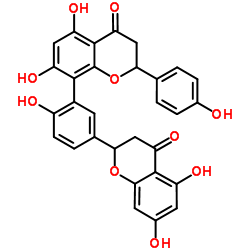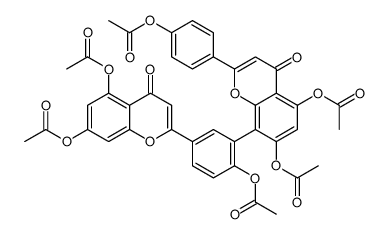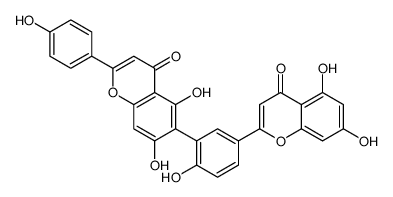amentoflavone

amentoflavone structure
|
Common Name | amentoflavone | ||
|---|---|---|---|---|
| CAS Number | 1617-53-4 | Molecular Weight | 538.458 | |
| Density | 1.7±0.1 g/cm3 | Boiling Point | 910.5±65.0 °C at 760 mmHg | |
| Molecular Formula | C30H18O10 | Melting Point | >300ºC | |
| MSDS | Chinese USA | Flash Point | 308.5±27.8 °C | |
Use of amentoflavoneAmentoflavone is a natural biflavone compound with many biological properties, including anti-inflammatory, antioxidative, and neuroprotective effects.IC50 value:Target:In vitro: In irradiated v79 cells, Pretreatment with amentoflavone 24 hours prior to 8 Gy 60Co γ-ray irradiation significantly inhibited apoptosis, promoted the G2 phase, decreased the concentration of ROS and mitochondrial mass [2]. Amentoflavone dose-dependently inhibited the viability of SW480 cells, and a high concentration of amentoflavone (150 μmol/L) obviously induced apoptosis of the cells [3]. In vivo: In epilepsy models, amentoflavone effectively prevented pilocarpine-induced epilepsy in a mouse kindling model, suppressed nuclear factor-κB activation and expression, inhibited excessive discharge of hippocampal neurons resulting in a reduction in epileptic seizures, shortened attack time, and diminished loss and apoptosis of hippocampal neurons [1]. |
| Name | amentoflavone |
|---|---|
| Synonym | More Synonyms |
| Description | Amentoflavone is a natural biflavone compound with many biological properties, including anti-inflammatory, antioxidative, and neuroprotective effects.IC50 value:Target:In vitro: In irradiated v79 cells, Pretreatment with amentoflavone 24 hours prior to 8 Gy 60Co γ-ray irradiation significantly inhibited apoptosis, promoted the G2 phase, decreased the concentration of ROS and mitochondrial mass [2]. Amentoflavone dose-dependently inhibited the viability of SW480 cells, and a high concentration of amentoflavone (150 μmol/L) obviously induced apoptosis of the cells [3]. In vivo: In epilepsy models, amentoflavone effectively prevented pilocarpine-induced epilepsy in a mouse kindling model, suppressed nuclear factor-κB activation and expression, inhibited excessive discharge of hippocampal neurons resulting in a reduction in epileptic seizures, shortened attack time, and diminished loss and apoptosis of hippocampal neurons [1]. |
|---|---|
| Related Catalog | |
| References |
| Density | 1.7±0.1 g/cm3 |
|---|---|
| Boiling Point | 910.5±65.0 °C at 760 mmHg |
| Melting Point | >300ºC |
| Molecular Formula | C30H18O10 |
| Molecular Weight | 538.458 |
| Flash Point | 308.5±27.8 °C |
| Exact Mass | 538.090027 |
| PSA | 181.80000 |
| LogP | 3.11 |
| Vapour Pressure | 0.0±0.3 mmHg at 25°C |
| Index of Refraction | 1.793 |
| InChIKey | YUSWMAULDXZHPY-UHFFFAOYSA-N |
| SMILES | O=c1cc(-c2ccc(O)c(-c3c(O)cc(O)c4c(=O)cc(-c5ccc(O)cc5)oc34)c2)oc2cc(O)cc(O)c12 |
| Storage condition | 2-8°C |
|
Amentoflavone
Revision number: 5
SAFETY DATA SHEET Section1. IDENTIFICATION Product name:Amentoflavone Revision number:5 Section2. HAZARDS IDENTIFICATION GHS classification PHYSICAL HAZARDSNot classified Not classified HEALTH HAZARDS ENVIRONMENTAL HAZARDSNot classified GHS label elements, including precautionary statements Pictograms or hazard symbolsNone No signal word Signal word Hazard statementsNone None Precautionary statements: Section3. COMPOSITION/INFORMATION ON INGREDIENTS Substance/mixture:Substance Components:Amentoflavone Percent:>98.0%(LC) CAS Number:1617-53-4 Chemical Formula:C30H18O10 Section4. FIRST AID MEASURES Inhalation:Remove victim to fresh air and keep at rest in a position comfortable for breathing. Get medical advice/attention if you feel unwell. Skin contact:Remove/Take off immediately all contaminated clothing. Rinse skin with water/shower. If skin irritation or rash occurs: Get medical advice/attention. Eye contact:Rinse cautiously with water for several minutes. Remove contact lenses, if present and easy to do. Continue rinsing. If eye irritation persists: Get medical advice/attention. Ingestion:Get medical advice/attention if you feel unwell. Rinse mouth. A rescuer should wear personal protective equipment, such as rubber gloves and air- Protection of first-aiders: tight goggles. Section5. FIRE-FIGHTING MEASURES Suitable extinguishingDry chemical, foam, water spray, carbon dioxide. media: Precautions for firefighters: Fire-extinguishing work is done from the windward and the suitable fire-extinguishing method according to the surrounding situation is used. Uninvolved persons should evacuate to a safe place. In case of fire in the surroundings: Remove movable containers if safe to do so. Amentoflavone Section5. FIRE-FIGHTING MEASURES Special protectiveWhen extinguishing fire, be sure to wear personal protective equipment. equipment for firefighters: Section6. ACCIDENTAL RELEASE MEASURES Personal precautions,Use personal protective equipment. Keep people away from and upwind of spill/leak. protective equipment and Entry to non-involved personnel should be controlled around the leakage area by emergency procedures: roping off, etc. Environmental precautions: Prevent product from entering drains. Methods and materials for Sweep dust to collect it into an airtight container, taking care not to disperse it. containment and cleaning Adhered or collected material should be promptly disposed of, in accordance with up: appropriate laws and regulations. Section7. HANDLING AND STORAGE Precautions for safe handling Handling is performed in a well ventilated place. Wear suitable protective equipment. Technical measures: Prevent dispersion of dust. Wash hands and face thoroughly after handling. Use a local exhaust if dust or aerosol will be generated. Advice on safe handling: Avoid contact with skin, eyes and clothing. Conditions for safe storage, including any incompatibilities Keep container tightly closed. Store in a refrigerator. Storage conditions: Store away from incompatible materials such as oxidizing agents. Heat-sensitive Packaging material:Comply with laws. Section8. EXPOSURE CONTROLS / PERSONAL PROTECTION Engineering controls:Install a closed system or local exhaust as possible so that workers should not be exposed directly. Also install safety shower and eye bath. Personal protective equipment Respiratory protection: Dust respirator. Follow local and national regulations. Hand protection:Protective gloves. Eye protection:Safety glasses. A face-shield, if the situation requires. Skin and body protection: Protective clothing. Protective boots, if the situation requires. Section9. PHYSICAL AND CHEMICAL PROPERTIES Solid Physical state (20°C): Form:Crystal- Powder Colour:White - Pale yellow green Odour:No data available pH: No data available Melting point/freezing point:No data available Boiling point/range:No data available No data available Flash point: Flammability or explosive limits: Lower:No data available No data available Upper: Relative density:No data available Solubility(ies): [Water]No data available [Other solvents]No data available Section10. STABILITY AND REACTIVITY Chemical stability:Stable under proper conditions. Possibility of hazardous No special reactivity has been reported. reactions: Amentoflavone Section10. STABILITY AND REACTIVITY Incompatible materials: Oxidizing agents Hazardous decomposition Carbon monoxide, Carbon dioxide products: Section11. TOXICOLOGICAL INFORMATION Acute Toxicity:No data available Skin corrosion/irritation: No data available Serious eyeNo data available damage/irritation: Germ cell mutagenicity: No data available Carcinogenicity: IARC =No data available NTP =No data available Reproductive toxicity:No data available Section12. ECOLOGICAL INFORMATION Ecotoxicity: Fish:No data available No data available Crustacea: Algae:No data available Persistence / degradability: No data available BioaccumulativeNo data available potential(BCF): Mobility in soil No data available Log Pow: Soil adsorption (Koc):No data available No data available Henry's Law constant(PaM3/mol): Section13. DISPOSAL CONSIDERATIONS Recycle to process, if possible. Consult your local regional authorities. You may be able to dissolve or mix material with a combustible solvent and burn in a chemical incinerator equipped with an afterburner and scrubber system. Observe all federal, state and local regulations when disposing of the substance. Section14. TRANSPORT INFORMATION Does not correspond to the classification standard of the United Nations Hazards Class: UN-No:Not listed Section15. REGULATORY INFORMATION Safe management ordinance of dangerous chemical product (State Council announces on January 26, 2002 and revised on February 16,2011): Safe use and production, the storage of a dangerous chemical, transport, loading and unloading were prescribed. Amentoflavone SECTION 16 - ADDITIONAL INFORMATION N/A |
| Personal Protective Equipment | Eyeshields;Gloves;type N95 (US);type P1 (EN143) respirator filter |
|---|---|
| Hazard Codes | Xn |
| Safety Phrases | S22-S24/25 |
| RIDADR | NONH for all modes of transport |
| WGK Germany | 3 |
| Precursor 1 | |
|---|---|
| DownStream 2 | |
|
Amentoflavone protects hippocampal neurons: anti-inflammatory, antioxidative, and antiapoptotic effects.
Neural Regen. Res. 10 , 1125-33, (2015) Amentoflavone is a natural biflavone compound with many biological properties, including anti-inflammatory, antioxidative, and neuroprotective effects. We presumed that amentoflavone exerts a neuropro... |
|
|
Simultaneous extraction of flavonoids from Chamaecyparis obtusa using deep eutectic solvents as additives of conventional extractions solvents.
J. Chromatogr. Sci. 53 , 836-40, (2015) Three flavones (quercetin, myricetin and amentoflavone) were extracted from Chamaecyparis obtusa leaves using deep eutectic solvents (DESs) as additives to conventional extractions solvents. Sixteen D... |
|
|
Flavonoids as opioid receptor ligands: identification and preliminary structure-activity relationships.
J. Nat. Prod. 70 , 1278-82, (2007) Flavonoids have been recognized as the active ingredients of many medicinal plant extracts due to interactions with proteins via phenolic groups and low toxicity. Here, we report the investigation of ... |
| amentoflavone |
| Didemethyl-ginkgetin |
| 4H-1-Benzopyran-4-one, 8-[5-(5,7-dihydroxy-4-oxo-4H-1-benzopyran-2-yl)-2-hydroxyphenyl]-5,7-dihydroxy-2-(4-hydroxyphenyl) |
| 4H-1-Benzopyran-4-one, 8-[5-(5,7-dihydroxy-4-oxo-4H-1-benzopyran-2-yl)-2-hydroxyphenyl]-5,7-dihydroxy-2-(4-hydroxyphenyl)- |
| 8-[5-(5,7-Dihydroxy-4-oxo-4H-chromen-2-yl)-2-hydroxyphenyl]-5,7-dihydroxy-2-(4-hydroxyphenyl)-4H-chromen-4-one |
| MFCD00017470 |
| Didemethylginkgetin |
| Tridemethylsciadopitysin |
| 4H-1-Benzopyran-4-one, 8-(5-(5,7-dihydroxy-4-oxo-4H-1-benzopyran-2-yl)-2-hydroxyphenyl)-5,7-dihydroxy-2-(4-hydroxyphenyl)- |
 CAS#:48236-96-0
CAS#:48236-96-0 CAS#:17482-37-0
CAS#:17482-37-0 CAS#:49620-13-5
CAS#:49620-13-5
